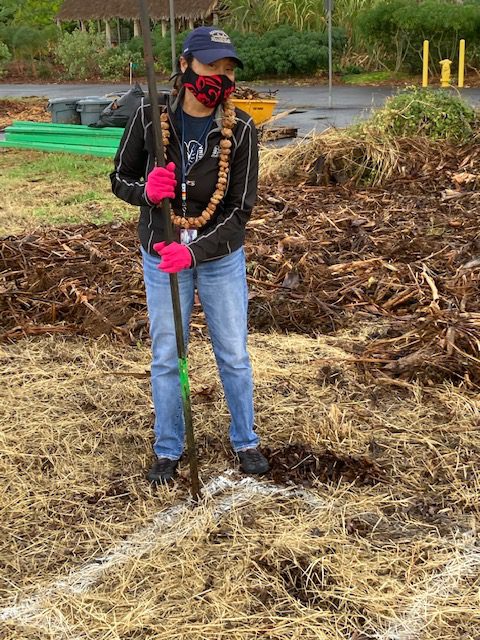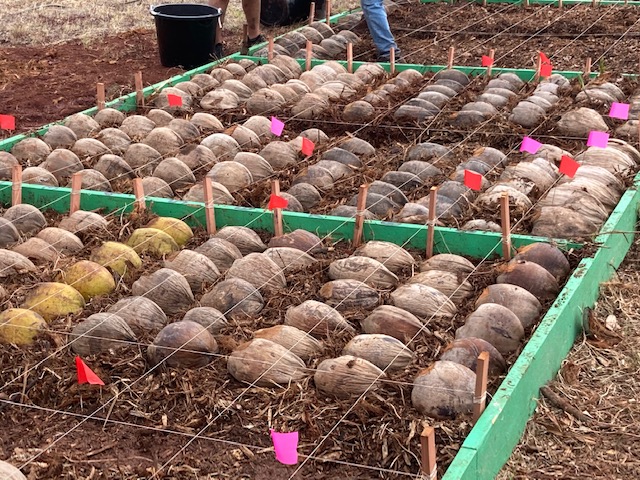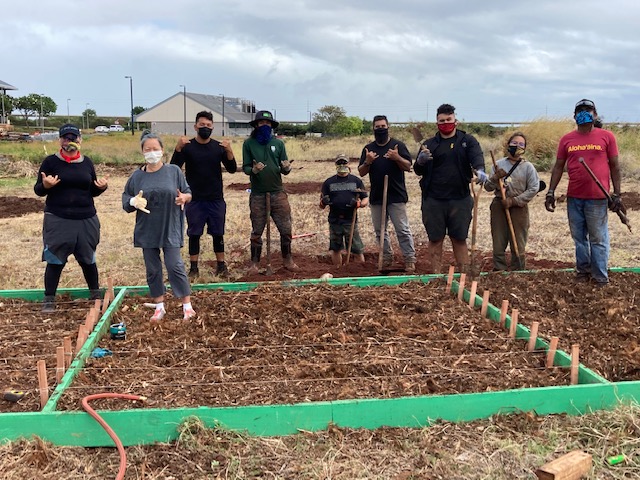The Uluniu Project — an effort to engage in the practices of food security, cultural dissemination of knowledge, and the growing of student leadership through aloha ʻāina work — continues to move forward at the University of Hawaiʻi–West Oʻahu with the recent placement of 264 niu (coconut) seedlings in its Niu Nursery.
Preparations have also begun for the first ʻulu (breadfruit) and niu plantings in its Uluniu Grove after the digging of 20 ditches for their placement.
This is an effort established by Indrajit Gunasekara, a UH West Oʻahu Financial Aid Officer, and Dr. Manulani Aluli Meyer, the Konohiki of Kūlana o Kapolei.
“We are living in mythic times,” Meyer said. “The Uluniu Project is about responding to the kāhea, the call.”
Meyer continued, “We are answering a call for relationship with land and thus to awaken to ways we can feed ourselves from the food of this relationship. Growing ʻulu/breadfruit and niu/coconut is one such response that will give us both — food and relationality.”
The project began in Fall 2017 with support from a small grant from UH System’s Sustainability Office, and continues with encouragement from the State Department of Land and Natural Resources’ Kaulunani Urban Forestry Program, Mālama Learning Center, MAʻO Farms, along with the UH West Oʻahu Aloha ʻĀina Student Service Club.
Since its inception, the project has grown with workshops reaching hundreds of community members and college students via presentations on campus, and at local and statewide conferences, schools, farms, and many educational sites on the purpose and need for food-producing trees — specifically ʻulu and niu.
The Uluniu Project team has gathered a community of scholars and indigenous practitioners to connect and strengthen cultural practices with science-based applications to highlight ʻulu and niu potential within the Hawaiian Islands. The Uluniu Project aims at Hawaiian cultural revitalization, environmental conservation, and local food production.
Today, project team members and partners are continuing to move forward within its designated area beside the current Student Organic Garden on the UH West Oʻahu campus. The team has successfully completed the Niu Nursery (10 feet by 40 feet), dug the ditches for all trees, and they are now in the process of soil rejuvenation and planting.

With the establishment of the UH West Oʻahu Niu Nursery, the goal is to document and germinate a collection of seed coconuts with special focus on Oceania dwarf (niuliʻi) and local niu varieties found in the ahupuaʻa of Honouliuli. Recently, 264 niu seedlings were placed in the nursery, where there are currently 24 different morphologically documented varieties.
The purpose of the nursery is to produce meaningful gifts that highlight the university’s Pahuhopu/Institutional Values: Mālama ‘Āina, Kaiāulu, Waiwai, and Hana Lawelawe; along with the activation of two key elements of its Theory of Distinctiveness: Sustainability and Innovation.
Among its other purposes are to acknowledge and document local niu diversity on the Leeward Coast through research and educational materials, and to promote a local and international coconut gene banking protocol to insure the perpetuation of Hawaiian niu diversity. Gunasekara is currently working with Dr. Noa Lincoln of UH Mānoa furthering the understanding of Hawaiʻi’s niu diversity.

The Uluniu Project’s plan for the Uluniu Grove is to plant a total of 10 ʻulu and 10 niu. Four different dwarf niu varieties will be grown, along with four varieties of ʻulu.
The Uluniu Grove promotes the indigenous coconut practice of Polymotu, used for millennia throughout Moana-nui-ākea, Oceania. This concept requires geographic isolation to perpetuate and conserve niu diversity. This niu practice here on campus will create a unique homogeneous gene bank of selective dwarf niu varieties.
Among other goals for the grove are to acknowledge ʻulu and Hawaiʻi’s dwarf niu diversity, and to connect to a larger community of students, educators, and programs; to incorporate indigenous applications for climate change planting mitigation aimed at scientific outcomes, and indigenous-based soil rejuvenation practices that produce promising outcomes that use natural elements found in abundance; and finally to develop ʻŌiwi Leadership in the area of Cultural Agroforestry.

Both the Niu Nursery and Uluniu Grove will also provide opportunities for UH West Oʻahu to enhance relationships with community partners through donations and gifts of coconuts and niu seed nuts and seedlings produced there, during events such as Arbor Day, Earth Day, and Food Bank distributions, as well as conferences and workshops.
In addition, the nursery and grove will help promote and provide quality space for UH System-wide students’ research projects on sustainability, soil rejuvenation, and local food production; and connect with scientific community members and others interested in these topics.
The Uluniu Project welcomes a limited number of volunteers for its work days — 8 to 11 a.m. most Saturdays — with current tasks such as amending soil, clearing the grove area, and planting native plants to surround the area and protect the moisture.
Volunteers must sign liability waiver forms and follow COVID-19 guidelines. Those interested in volunteering may contact Aloha ʻĀina Student Service Club President Jesse Mikasobe-Kealiinohomoku at jmk23@hawaii.edu or Aloha ʻĀina Student Service Club Advisor and Uluniu Project Coordinator Gunasekara at indrajit@hawaii.edu for more information.
